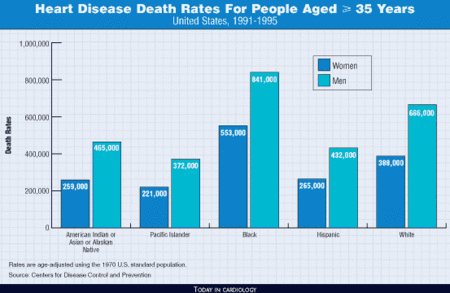Increased awareness crucial to CVD prevention in minority patients
Minority patients are less likely to be screened for CVD risk factors and less likely to receive risk-reducing treatments.
In the United States, cardiovascular disease disproportionately affects certain groups of minority patients. Compared with whites, blacks, Hispanic Americans and South Asian Americans have a higher prevalence of CVD, as well as a greater prevalence of risk factors such as dyslipidemia, hypertension, obesity and diabetes.
At the same time, many minority patients are often less likely to be screened for CVD risk factors and less likely to receive risk-reducing treatments. Furthermore, minority patients, in general, have traditionally been underrepresented in clinical trials of cardiovascular disease.
Keith C. Ferdinand, MD, medical director of Heartbeats Life Center in New Orleans, recently spoke with Cardiology Today regarding CVD risk in minority patients and what can be done to reduce this risk. Ferdinand said increasing awareness of the risk profiles in minority patients is an important first step in helping to identify persons who would benefit from treatment and, ultimately, to reducing the rates of CVD in these patient populations.

Increased risk
Ferdinand told Cardiology Today that more information is still needed to better understand why certain minority populations have an increased threat of CVD in the United States. He said studies of this issue are ongoing and it is likely that several factors contribute to the disproportionate degree of morbidity and mortality. “There is some discussion of genetics and pathophysiology as components of racial differences in disease prevalence and outcomes in certain minority patients,” Ferdinand said. “Clearly lifestyle, access to expert primary care and specialized care, and the ability to afford medications and newer technology make a large difference in how patients are able to identify and survive CVD.”
The Western lifestyle may play a role in increasing CVD risk in these patient populations. “It has been demonstrated in traditionally rural or non-industrialized populations that hypertension is less prevalent and does not increase with age,” Ferdinand noted. “However, as populations in Africa and Asia urbanize and Westernize, hypertension and coronary heart disease rates are expected to increase.” He cited several studies conducted in Africa in recent years that have demonstrated that increasing hypertension rates may be correlated with increasing urbanization.
Ferdinand said that CVD remains much more prevalent in Western countries. “In general, hypertension and cardiovascular diseases appear to be conditions of Western lifestyle, especially among populations who are unable to recognize or have difficulty understanding how to avoid high saturated fats and high-sodium foods,” he said.
There may also be certain factors specifically related to race and ethnicity that lead to increased CVD risks in minority groups. For example, Ferdinand noted that blacks have a higher rate of salt-sensitive, volume-dependent hypertension. Moreover, metabolic syndrome is more common among certain Hispanic populations. South Asians are at a greater risk for an earlier and more intense form of atherosclerosis.
Reducing risks
Physicians and other practitioners may need to take extra steps to help minority patients reduce their risk of CVD, Ferdinand said. This is a particular challenge because minority patients are less likely to see a physician on a regular basis. “Many minority patients need an even higher degree of specialized care because their first interaction with the health care delivery system may be at a point where comorbid conditions abound,” Ferdinand said. “For instance, especially in disadvantaged communities, the person’s first primary care visit or specialty care intervention may include uncontrolled diabetes, stage 2 blood pressure, left ventricular dysfunction and renal insufficiency.”
Minority patients need to be informed of the increased dangers they face. “Patients should be students of their own family histories and recognize that disease often is duplicated from generation to generation, as are certain deleterious lifestyles within a family,” he said. – by Jay Lewis
For more information:
- Ferdinand K. Managing cardiovascular risk in minority patients. J Natl Med Assoc. 2005;97:459-466.
